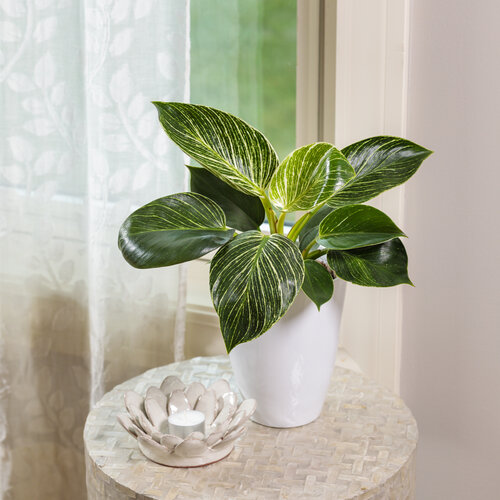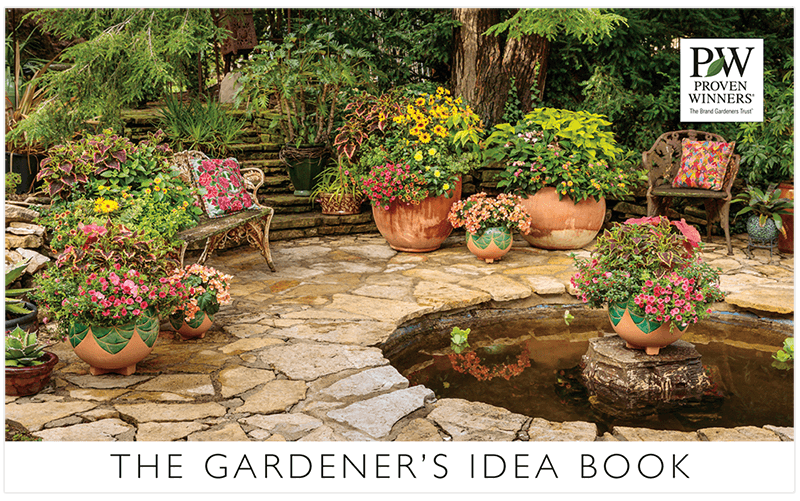Philodendron - The Ultimate Growing Guide from Proven Winners®
Grow this beautiful easy-care houseplant in your home or office
 Check here to see if your Local Garden Center or The Home Depot® is carrying leafjoy®.
Check here to see if your Local Garden Center or The Home Depot® is carrying leafjoy®.
Philodendron is a common houseplant that is grown for the striking foliage. The lush oval, arrow- or heart-shaped leaves add a vibrant touch to indoor living spaces, with a range of colors and patterns to suit any decor. There are two basic types of philodendron with different growth habits. Vining types with a climbing or trailing habit are the most commonly grown, though there are varieties with an upright bushy growth habit as well.
Native to tropical rainforests of Central and South America, philodendron does best in an environment that mimics its native habitat, but is tolerant of a range of growing conditions. One of the easiest houseplants to grow, it will thrive indoors when provided with basic care. Here’s how to grow and use philodendron in your home or office.
PHILODENDRON CARE & PLANTING
How to plant: Philodendron has a rapid growth rate and will need repotting every 2-3 years. Remove your plant from its pot and inspect the roots. If roots are circling around the outside of the root ball, it’s time to transplant into a bigger pot. The best time to repot these plants is in spring or summer when they are actively growing.
- Provide a new pot that is 1-2 inches larger in diameter and slightly deeper than the old pot.
- Remove plant from its current pot and check the roots for any signs of rot or other damage.
- Cut out any damaged portions as needed.
- Inspect plants for any other pest or disease problems.
- If the new pot has been previously used, clean and sterilize it before reusing.
- Make sure there are adequate drainage holes to allow excess water to drain out the bottom.
- Place fresh potting soil in the bottom of the new pot.
- Position the philodendron plant in the new pot at the same level it was in the previous container.
- Add fresh soil around the sides of the pot up to the base of the plant stem.
- Tamp soil down gently to remove air pockets.
- Water until liquid comes out of the drainage holes at the bottom of the pot.
Light requirements: Grow philodendron in medium to bright indirect light near a window. Some varieties can tolerate low light. Direct sunlight may cause leaf burn, while not enough light can result in foliage color to fade.
Discover more high-light plants for bright spaces.
Temperature: Philodendrons prefer warmer temperatures as found in their native habitat. The ideal temperature range is between 60-85 degrees F. Temperatures below 55 degrees F can cause plant damage. Avoid placing plants near heating or cooling vents. Drafts or sudden swings in temperature can cause plant stress.
Humidity: Though philodendron prefers high humidity between 60-80%, it can tolerate drier conditions typically found in indoor environments. To boost room humidity, mist plant leaves, place plants on trays filled with water and pebbles, or use a room humidifier.
Soil: The best soil for philodendron plants is rich, well-drained potting mix with a slightly acidic pH.
Watering: Philodendron plants prefer evenly moist soil that doesn’t get too soggy. Avoid overwatering to prevent root rot. Reduce watering in winter when plant growth slows.
Fertilizing: During spring and summer when plants are actively growing, apply a balanced houseplant fertilizer once a month according to package instructions. Cease fertilizing during winter months when plant growth slows down.
Pruning: If vining philodendron plants become too long or leggy, they can be trimmed back as needed. Prune in spring or summer when growth is active. Remove yellow leaves or damaged foliage as it occurs.
Learn more tips on growing houseplants.
TRY THESE PROVEN WINNERS® LEAFJOY™ VARIETIES
 Prismacolor™ Orange you Gorgeous™ produces vibrant spade-shaped leaves with mottled bright orange and red highlights that fade to gold and green for citrusy tropical appeal. Plants have a compact vining habit, making this a good choice to grow on a moss pole or display on a shelf. Prismacolor™ Orange you Gorgeous™ produces vibrant spade-shaped leaves with mottled bright orange and red highlights that fade to gold and green for citrusy tropical appeal. Plants have a compact vining habit, making this a good choice to grow on a moss pole or display on a shelf. |
 Prismacolor™ Green Diamond tolerates low light, making it suitable for darker rooms. This variety produces glossy emerald green leaves on upright plants that can reach 3 feet tall, making this a versatile addition to office or entry floor displays. Prismacolor™ Green Diamond tolerates low light, making it suitable for darker rooms. This variety produces glossy emerald green leaves on upright plants that can reach 3 feet tall, making this a versatile addition to office or entry floor displays. |
 Prismacolor™ Birkin is a variegated philodendron with classic elegance. The dark oval-shaped green leaves have thin creamy white pinstripes that radiate out from the midribs. This variety has an upright compact habit suitable for display on an end table or desktop. Prismacolor™ Birkin is a variegated philodendron with classic elegance. The dark oval-shaped green leaves have thin creamy white pinstripes that radiate out from the midribs. This variety has an upright compact habit suitable for display on an end table or desktop. |
 Prismacolor™ Florida Green is a somewhat rare variety with striking dark-green leaves that are arrow-shaped and deeply lobed. Grow this rapid climber on a moss pole or other support that its aerial roots can attach to. Prismacolor™ Florida Green is a somewhat rare variety with striking dark-green leaves that are arrow-shaped and deeply lobed. Grow this rapid climber on a moss pole or other support that its aerial roots can attach to. |
 Prismacolor™ Lemon Lime, not to be confused with ‘Lemon Lime’ heartleaf philodendron, has an upright climbing habit. The elongated leaves become bright chartreuse when displayed in a south-facing window with bright indirect light. Train on a moss pole or trellis as plants mature and begin to climb. Prismacolor™ Lemon Lime, not to be confused with ‘Lemon Lime’ heartleaf philodendron, has an upright climbing habit. The elongated leaves become bright chartreuse when displayed in a south-facing window with bright indirect light. Train on a moss pole or trellis as plants mature and begin to climb. |
FREQUENTLY ASKED QUESTIONS
Is philodendron a good indoor plant?
Philodendron plants are tolerant of different growing conditions and are easy to care for, making them a good houseplant for beginners. Here are ways to incorporate indoor plants into your home or office.
Where should I place a Philodendron in my house?
Provide a location near a window with bright indirect light out of direct sun. Some varieties can tolerate less light.
Are philodendrons toxic?
Philodendron can be toxic to people and pets. Display plants on a high shelf or in hanging baskets to keep out of reach of curious children and pets.
How often do you water philodendron?
Water your philodendron plant when the soil surface is dry 1-2 inches deep. This is usually about once a week, or less often in winter.
Should I mist my philodendron?
Philodendron plants prefer the high humidity found in their native habitat. If your home or office has drier air, mist plants regularly to hydrate the foliage.
Can philodendron grow in water?
Some varieties such as heartleaf philodendron can be propagated from cuttings and grown in water. Choose stems with healthy growth and remove bottom leaves before placing cuttings in water. Change water every few days and keep containers clean to prevent bacterial growth and other problems.

What plant is mistaken for a Philodendron?
Two similar plants to philodendron are pothos and monstera. When comparing pothos vs. philodendron, pothos leaves are thicker, more textured and may be asymmetrical, while heartleaf philodendron foliage is smoother and more uniformly heart-shaped.
For philodendron vs. monstera, these two are often confused because of their similar appearance and common names. Split-leaf philodendron, formerly Philodendron bipinnatifidum, is now classified as Thaumatophyllum bipinnatifidum. Monstera also goes by the common name of split-leaf philodendron even though it belongs to the Monstera genus.
Get more information on pothos.
HOW TO USE PHILODENDRON IN YOUR HOME OR OFFICE
Here’s how to display philodendron plants in your home or office:
- Train a philodendron vine up a moss pole, trellis or other vertical support and display in a bright entryway or corner of a room.
- Plant a bushy type in a colorful decorative pot that coordinates with the foliage color. Place on a dining room table as a centerpiece.
- Use a plant hanger or hanging basket to display a trailing philodendron in a kitchen or bathroom to take advantage of the higher room humidity.
- Select a variety that matches your room decor. Display in a complementary pot on a coffee table, end table or shelf.
- Group philodendron alongside other houseplants with similar growing needs for a captivating display and to reduce plant maintenance.
- Train a vining type along a window frame or sill, keeping the vines in place with cup hooks.
- Decorate a fireplace mantle with trailing philodendron and allow to sprawl as a living garland.
- Place a smaller specimen on a desktop where you can enjoy looking at it while you work.
Get more tips for decorating with plants.
Find more on choosing the perfect houseplant.
PHILODENDRON COMPANIONS
Here are some of the best houseplants to grow alongside philodendrons:
- Beautifall® Jade pothos
- Urban Arches™ Pixie Punk™ spider plant
- Catamount™ Tasmanian Tiger dumb cane
- Color Full® Xena™ velvet calathea
- Savory Delights™ Sweet and Sour™ peperomia
- Network News™ Primetime™ nerve plant
Want to explore other beautiful indoor plants? Learn how to grow and use these houseplants in your home and office:
Plus, here are some of the best indoor plants for beginners.




